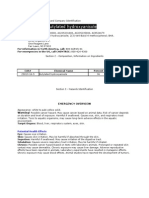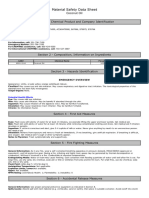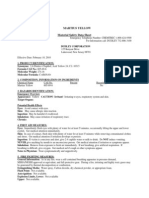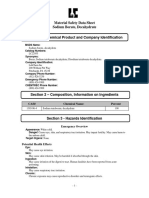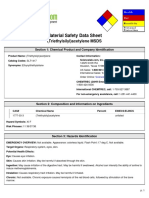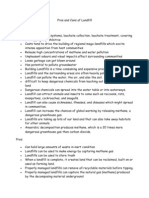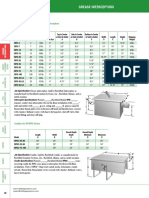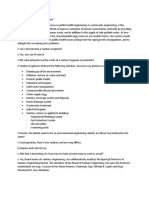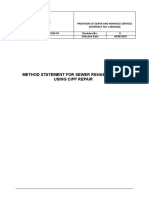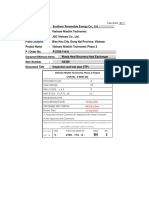Saccharin Sodium
Saccharin Sodium
Uploaded by
api-263411629Copyright:
Available Formats
Saccharin Sodium
Saccharin Sodium
Uploaded by
api-263411629Original Title
Copyright
Available Formats
Share this document
Did you find this document useful?
Is this content inappropriate?
Copyright:
Available Formats
Saccharin Sodium
Saccharin Sodium
Uploaded by
api-263411629Copyright:
Available Formats
Material Safety Data Sheet
Saccharin Sodium
Section 1 - Chemical Product and Company Identification
MSDS Name: Saccharin Sodium
Catalog Numbers: S394-100LB, S394-12, S394-212, S394-500
Synonyms: Sodium saccharin; 1,2-Benzisothiazol-3(2H)-one, 1,1-dioxide, sodium salt; Saccharin, sodium
salt; Saccharin soluble.
Company Identification:
Fisher Scientific
1 Reagent Lane
Fair Lawn, NJ 07410
For information, call: 201-796-7100
Emergency Number: 201-796-7100
For CHEMTREC assistance, call: 800-424-9300
For International CHEMTREC assistance, call: 703-527-3887
Section 2 - Composition, Information on Ingredients
CAS# Chemical Name Percent EINECS/ELINCS
128-44-9 Sodium saccharin 100 204-886-1
Section 3 - Hazards Identification
EMERGENCY OVERVIEW
Appearance: white solid.
Caution! May cause irritation.
Target Organs: None.
Potential Health Effects
Eye: May cause eye irritation.
Skin: Low hazard for usual industrial handling.
Ingestion: The toxicological properties of this substance have not been fully investigated.
Inhalation: Inhalation of dust may cause respiratory tract irritation.
Chronic: Several studies in rats & mice have linked sodium saccharin to bladder tumors, but the
mechanism believed to induce cancer in those animals does not appear to occur in humans. Rats & mice
have a different urinary pH than do humans.
Section 4 - First Aid Measures
Eyes: Flush eyes with plenty of water for at least 15 minutes, occasionally lifting the upper and lower
eyelids. Get medical aid.
Skin: Flush skin with plenty of water for at least 15 minutes while removing contaminated clothing and
shoes. Get medical aid if irritation develops or persists.
Ingestion: Get medical aid if irritation or symptoms occur.
Inhalation: Remove from exposure and move to fresh air immediately. Get medical aid if cough or other
symptoms appear.
Notes to Physician: Treat symptomatically and supportively.
Section 5 - Fire Fighting Measures
General Information: As in any fire, wear a self-contained breathing apparatus in pressure-demand,
MSHA/NIOSH (approved or equivalent), and full protective gear.
Extinguishing Media: Use water spray, dry chemical, carbon dioxide, or chemical foam.
Flash Point: Not applicable.
Autoignition Temperature: Not applicable.
Explosion Limits, Lower:Not available.
Upper: Not available.
NFPA Rating: (estimated) Health: 0; Flammability: 1; Instability: 0
Section 6 - Accidental Release Measures
General Information: Use proper personal protective equipment as indicated in Section 8.
Spills/Leaks: Vacuum or sweep up material and place into a suitable disposal container. Avoid generating
dusty conditions. Provide ventilation.
Section 7 - Handling and Storage
Handling: Use with adequate ventilation. Minimize dust generation and accumulation. Avoid contact with
skin and eyes. Avoid ingestion and inhalation.
Storage: Store in a tightly closed container. Store in a cool, dry, well-ventilated area away from
incompatible substances.
Section 8 - Exposure Controls, Personal Protection
Engineering Controls: Good general ventilation should be sufficient to control airborne levels.
Exposure Limits
Chemical Name ACGIH NIOSH OSHA - Final PELs
Sodium saccharin none listed none listed none listed
OSHA Vacated PELs: Sodium saccharin: No OSHA Vacated PELs are listed for this chemical.
Personal Protective Equipment
Eyes: Wear appropriate protective eyeglasses or chemical safety goggles as described by OSHA's eye and
face protection regulations in 29 CFR 1910.133 or European Standard EN166.
Skin: Wear appropriate protective gloves to prevent skin exposure.
Clothing: Wear appropriate protective clothing to minimize contact with skin.
Respirators: Follow the OSHA respirator regulations found in 29 CFR 1910.134 or European Standard EN
149. Use a NIOSH/MSHA or European Standard EN 149 approved respirator if exposure limits are exceeded
or if irritation or other symptoms are experienced.
Section 9 - Physical and Chemical Properties
Physical State: Solid
Appearance: white
Odor: none reported
pH: Not available.
Vapor Pressure: Not available.
Vapor Density: Not available.
Evaporation Rate:Not available.
Viscosity: Not available.
Boiling Point: Not available.
Freezing/Melting Point:Not available.
Decomposition Temperature:Not available.
Solubility: Freely Soluble.
Specific Gravity/Density:Not available.
Molecular Formula:C7H4O3NSNa
Molecular Weight:205.17
Section 10 - Stability and Reactivity
Chemical Stability: Stable under normal temperatures and pressures.
Conditions to Avoid: Dust generation.
Incompatibilities with Other Materials: Strong oxidizing agents.
Hazardous Decomposition Products: Nitrogen oxides, carbon monoxide, oxides of sulfur, carbon dioxide,
toxic fumes of sodium oxide.
Hazardous Polymerization: Has not been reported.
Section 11 - Toxicological Information
RTECS#:
CAS# 128-44-9: DE4550000
LD50/LC50:
CAS# 128-44-9:
Oral, mouse: LD50 = 17500 mg/kg;
Oral, rat: LD50 = 14200 mg/kg;
.
Carcinogenicity:
CAS# 128-44-9: Not listed by ACGIH, IARC, NTP, or CA Prop 65.
Epidemiology: Several studies in rats & mice have linked sodium saccharin to bladder tumors, but the
mechanism believed to induce cancer in those animals does not appear to occur in humans.
Teratogenicity: No data available.
Reproductive Effects: See actual entry in RTECS for complete information.
Mutagenicity: See actual entry in RTECS for complete information.
Neurotoxicity: No data available.
Other Studies:
Section 12 - Ecological Information
Ecotoxicity: No data available. The product is chemically identical to the natural amino acid L-Serine and
can therefore can be degraded microbiologically.
Environmental: No information available.
Physical: No information available.
Other: No information available.
Section 13 - Disposal Considerations
Chemical waste generators must determine whether a discarded chemical is classified as a hazardous
waste. US EPA guidelines for the classification determination are listed in 40 CFR Parts 261.3. Additionally,
waste generators must consult state and local hazardous waste regulations to ensure complete and accurate
classification.
RCRA P-Series: None listed.
RCRA U-Series: None listed.
Section 14 - Transport Information
US DOT Canada TDG
Shipping Name: Not regulated as a hazardous material No information available.
Hazard Class:
UN Number:
Packing Group:
Section 15 - Regulatory Information
US FEDERAL
TSCA
CAS# 128-44-9 is listed on the TSCA inventory.
Health & Safety Reporting List
None of the chemicals are on the Health & Safety Reporting List.
Chemical Test Rules
None of the chemicals in this product are under a Chemical Test Rule.
Section 12b
None of the chemicals are listed under TSCA Section 12b.
TSCA Significant New Use Rule
None of the chemicals in this material have a SNUR under TSCA.
CERCLA Hazardous Substances and corresponding RQs
None of the chemicals in this material have an RQ.
SARA Section 302 Extremely Hazardous Substances
None of the chemicals in this product have a TPQ.
Section 313 No chemicals are reportable under Section 313.
Clean Air Act:
This material does not contain any hazardous air pollutants.
This material does not contain any Class 1 Ozone depletors.
This material does not contain any Class 2 Ozone depletors.
Clean Water Act:
None of the chemicals in this product are listed as Hazardous Substances under the CWA.
None of the chemicals in this product are listed as Priority Pollutants under the CWA.
None of the chemicals in this product are listed as Toxic Pollutants under the CWA.
OSHA:
None of the chemicals in this product are considered highly hazardous by OSHA.
STATE
CAS# 128-44-9 can be found on the following state right to know lists: Pennsylvania, Massachusetts.
California Prop 65
California No Significant Risk Level: None of the chemicals in this product are listed.
European/International Regulations
European Labeling in Accordance with EC Directives
Hazard Symbols:
Not available.
Risk Phrases:
Safety Phrases:
WGK (Water Danger/Protection)
CAS# 128-44-9: 0
Canada - DSL/NDSL
CAS# 128-44-9 is listed on Canada's DSL List.
Canada - WHMIS
not available.
This product has been classified in accordance with the hazard criteria of the Controlled Products
Regulations and the MSDS contains all of the information required by those regulations.
Canadian Ingredient Disclosure List
Section 16 - Additional Information
MSDS Creation Date: 5/12/1998
Revision #6 Date: 11/20/2008
The information above is believed to be accurate and represents the best information currently available to us. However, we make no warranty
of merchantability or any other warranty, express or implied, with respect to such information, and we assume no liability resulting from its use.
Users should make their own investigations to determine the suitability of the information for their particular purposes. In no event shall Fisher
be liable for any claims, losses, or damages of any third party or for lost profits or any special, indirect, incidental, consequential or exemplary
damages, howsoever arising, even if Fisher has been advised of the possibility of such damages.
You might also like
- Material Safety Data Sheet: Florisil AdsorbentDocument5 pagesMaterial Safety Data Sheet: Florisil AdsorbentYeyen Parida MyNo ratings yet
- MSDS of 4-Nitrobenzaldehyde (Cas 555-16-8)Document3 pagesMSDS of 4-Nitrobenzaldehyde (Cas 555-16-8)candykivNo ratings yet
- Material Safety Data Sheet BoraxDocument5 pagesMaterial Safety Data Sheet Boraxratnasari2223No ratings yet
- Material Safety Data Sheet: Mineral Oil, Light and HeavyDocument6 pagesMaterial Safety Data Sheet: Mineral Oil, Light and HeavyGoogoobahNo ratings yet
- Material Safety Data Sheet: Sucrose Section 1 - Chemical Product and Company IdentificationDocument6 pagesMaterial Safety Data Sheet: Sucrose Section 1 - Chemical Product and Company IdentificationSundari PratiwiNo ratings yet
- Bic Sodio Tongbai Malan MSDSDocument7 pagesBic Sodio Tongbai Malan MSDSFIORELLA VANESSA MAITA MUCHANo ratings yet
- MSDS Sodium Bicarbonate MalanDocument7 pagesMSDS Sodium Bicarbonate Malandhono vandieselNo ratings yet
- Material Safety Data Sheet: Ampicillin Sodium Salt Section 1 - Chemical Product and Company IdentificationDocument5 pagesMaterial Safety Data Sheet: Ampicillin Sodium Salt Section 1 - Chemical Product and Company IdentificationbeletristicliteraturNo ratings yet
- Msds DibenzalasetonDocument5 pagesMsds DibenzalasetonFedi Rahman TaraNo ratings yet
- Material Safety Data Sheet: Phenolphthalein, IndicatorDocument5 pagesMaterial Safety Data Sheet: Phenolphthalein, IndicatorYomi MedaNo ratings yet
- Bic Sodio Shandong MSDSDocument7 pagesBic Sodio Shandong MSDSFIORELLA VANESSA MAITA MUCHANo ratings yet
- Material Safety Data Sheet: Malachite Green OxalateDocument5 pagesMaterial Safety Data Sheet: Malachite Green OxalatecarbouNo ratings yet
- MSDS HPMCDocument7 pagesMSDS HPMCJAUHARULALMAKNUNNo ratings yet
- Material Safety Data Sheet: Section 1 - Chemical Product and Company IdentificationDocument5 pagesMaterial Safety Data Sheet: Section 1 - Chemical Product and Company IdentificationFortune FireNo ratings yet
- Potassium Formate MSDSDocument6 pagesPotassium Formate MSDSHeris SitompulNo ratings yet
- MSDS Name: Butylated Hydroxyanisole: Emergency OverviewDocument6 pagesMSDS Name: Butylated Hydroxyanisole: Emergency OverviewAgilentechNo ratings yet
- Material Safety Data SheetDocument7 pagesMaterial Safety Data SheetNur HidayantiNo ratings yet
- MSDS 2Document6 pagesMSDS 2Oka29No ratings yet
- Files MSDS Ca CL 2Document5 pagesFiles MSDS Ca CL 2Muhammad Alfikri RidhatullahNo ratings yet
- Zinc Metal MsdsDocument7 pagesZinc Metal MsdsShamira Yessa Lazaro EspinosaNo ratings yet
- MSDS - Mercury (I) ChlorideDocument5 pagesMSDS - Mercury (I) ChlorideLailal HaqimNo ratings yet
- Material Safety Data SheetDocument7 pagesMaterial Safety Data SheetZahra AnnisaNo ratings yet
- MsdsDocument5 pagesMsdsSiva KumarNo ratings yet
- 122 20 3 Fisher ScientificDocument5 pages122 20 3 Fisher ScientificSatrio ChristiawanNo ratings yet
- (4-Chlorophenylthio) Acetic Acid MSDS: Section 1: Chemical Product and Company IdentificationDocument5 pages(4-Chlorophenylthio) Acetic Acid MSDS: Section 1: Chemical Product and Company IdentificationPulbere NeagraNo ratings yet
- Material Safety Data Sheet: Barium ChlorideDocument6 pagesMaterial Safety Data Sheet: Barium ChloriderozanNo ratings yet
- DicyanineDocument4 pagesDicyanineHennie Namløs ThorneNo ratings yet
- Msds 03880.htmDocument5 pagesMsds 03880.htmdeekshithNo ratings yet
- Material Safety Data Sheet: Poly (Chloroprene)Document5 pagesMaterial Safety Data Sheet: Poly (Chloroprene)Paul Christian Rojas FloresNo ratings yet
- Material Safety Data Sheet: Einecs No. 235-113 - 6Document6 pagesMaterial Safety Data Sheet: Einecs No. 235-113 - 6sujoy_jkbs2011No ratings yet
- Anthranilic Acid Section 1 - Chemical Product and Company IdentificationDocument7 pagesAnthranilic Acid Section 1 - Chemical Product and Company IdentificationDinesh22No ratings yet
- MSDS Boric Acid PowderDocument6 pagesMSDS Boric Acid PowderRáńéśh NeshNo ratings yet
- Material Safety Data Sheet: Emer Gency O Ver ViewDocument4 pagesMaterial Safety Data Sheet: Emer Gency O Ver Viewamanigamil50No ratings yet
- Martius Yellow Material Safety Data SheetDocument4 pagesMartius Yellow Material Safety Data SheetdeviycNo ratings yet
- Material Safety Data Sheet: Section 1 - Chemical Product and Company IdentificationDocument6 pagesMaterial Safety Data Sheet: Section 1 - Chemical Product and Company IdentificationRahasia Tahu RahasiaNo ratings yet
- Violeta Metilo EnglishDocument7 pagesVioleta Metilo EnglishMarielle RiveraNo ratings yet
- MSDS SMBSDocument9 pagesMSDS SMBSkilin arkalNo ratings yet
- Msds UreaDocument5 pagesMsds UreaHunterlan Register FilanNo ratings yet
- Glycerin (Humco)Document6 pagesGlycerin (Humco)Saqib AliNo ratings yet
- Olive OilDocument5 pagesOlive OilFrederic PutrantoNo ratings yet
- Material Safety Data Sheet Citric Acid, Anhydrous, U.S.P./N.F. (Granular)Document6 pagesMaterial Safety Data Sheet Citric Acid, Anhydrous, U.S.P./N.F. (Granular)Trya AdeNo ratings yet
- Sodium Formate 98% Msds InnoasDocument6 pagesSodium Formate 98% Msds Innoasjooyaa30No ratings yet
- Material Safety Data Sheet: Emergency Overview Caution!Document6 pagesMaterial Safety Data Sheet: Emergency Overview Caution!t.shannon5508No ratings yet
- MSDS Aluminum PhosphateDocument7 pagesMSDS Aluminum PhosphateMehmet Besim SacilikNo ratings yet
- Material Safety Data Sheet: Section 1 - Chemical Product and Company IdentificationDocument5 pagesMaterial Safety Data Sheet: Section 1 - Chemical Product and Company IdentificationManikandan VijayanNo ratings yet
- Msds Hydroxyethyl Cellulose HecDocument5 pagesMsds Hydroxyethyl Cellulose HecWANGYUSHENG Kima Chemical Co LtdNo ratings yet
- MSDS BesiDocument7 pagesMSDS BesiRiza ApreliaNo ratings yet
- Material Safety Data Sheet: Section 1 - Chemical Product and Company IdentificationDocument7 pagesMaterial Safety Data Sheet: Section 1 - Chemical Product and Company IdentificationIlham NugrahaNo ratings yet
- TBTU Msds (Acros Organics) PDFDocument5 pagesTBTU Msds (Acros Organics) PDFBigbearBigbearNo ratings yet
- Sodium Borate DecahydrateDocument5 pagesSodium Borate Decahydrateamalia mustika hayatiNo ratings yet
- Msds of TccaDocument5 pagesMsds of Tccadie_1No ratings yet
- MSDS Acidum BoricumDocument6 pagesMSDS Acidum BoricumRiga 'Azoe' AlrianiNo ratings yet
- Material Safety Data SheetDocument5 pagesMaterial Safety Data SheetDesyNo ratings yet
- Msds Low Substituted Hydroxypropyl Cellulose L-HPCDocument7 pagesMsds Low Substituted Hydroxypropyl Cellulose L-HPCWANGYUSHENG Kima Chemical Co LtdNo ratings yet
- MSDS Methylene BlueDocument7 pagesMSDS Methylene BluetikhamartikhaNo ratings yet
- Msds Carboxy Methyl Cellulose CMCDocument5 pagesMsds Carboxy Methyl Cellulose CMCWANGYUSHENG Kima Chemical Co LtdNo ratings yet
- Material Safety Data Sheet: (Triethylsilyl) Acetylene MSDSDocument5 pagesMaterial Safety Data Sheet: (Triethylsilyl) Acetylene MSDSPulbere NeagraNo ratings yet
- (S) - (-) - 2-Amino-4-Pentenoic Acid, 98% MSDS: Section 1: Chemical Product and Company IdentificationDocument6 pages(S) - (-) - 2-Amino-4-Pentenoic Acid, 98% MSDS: Section 1: Chemical Product and Company IdentificationPulbere NeagraNo ratings yet
- Exposure due to Radionuclides in Food Other than During a Nuclear or Radiological Emergency: Part 1: Technical MaterialFrom EverandExposure due to Radionuclides in Food Other than During a Nuclear or Radiological Emergency: Part 1: Technical MaterialNo ratings yet
- A Consumerýs Dictionary of Household, Yard and Office Chemicals: Complete Information About Harmful and Desirable Chemicals Found in Everyday Home Products, Yard Poisons, and Office PollutersFrom EverandA Consumerýs Dictionary of Household, Yard and Office Chemicals: Complete Information About Harmful and Desirable Chemicals Found in Everyday Home Products, Yard Poisons, and Office PollutersNo ratings yet
- Yd903 MsdsDocument3 pagesYd903 Msdsapi-263411629No ratings yet
- SfmsdsDocument5 pagesSfmsdsapi-263411629No ratings yet
- Natrium Bikarbonat PDFDocument5 pagesNatrium Bikarbonat PDFJ FadliNo ratings yet
- Soda Ash Lite Natural MsdsDocument3 pagesSoda Ash Lite Natural Msdsapi-263411629No ratings yet
- Yd128 MsdsDocument3 pagesYd128 Msdsapi-263411629No ratings yet
- Stearic Acid MsdsDocument5 pagesStearic Acid Msdsapi-263411629No ratings yet
- Caustic Sada Flakes MsdsDocument9 pagesCaustic Sada Flakes Msdsapi-263411629No ratings yet
- Saccharin MsdsDocument5 pagesSaccharin Msdsapi-263411629No ratings yet
- Soda Ash Dense MsdsDocument3 pagesSoda Ash Dense Msdsapi-263411629No ratings yet
- Ginasul46p MsdsDocument4 pagesGinasul46p Msdsapi-263411629No ratings yet
- Caustic Sada Flakes MsdsDocument9 pagesCaustic Sada Flakes Msdsapi-263411629No ratings yet
- Ea MsdsDocument6 pagesEa Msdsapi-263411629No ratings yet
- Yd128 MsdsDocument3 pagesYd128 Msdsapi-263411629No ratings yet
- Formic MsdsDocument6 pagesFormic Msdsapi-263411629No ratings yet
- Msds MelicDocument5 pagesMsds Melicapi-263411629No ratings yet
- Aos PDocument4 pagesAos Papi-263411629No ratings yet
- MSDSPJDocument6 pagesMSDSPJapi-263411629No ratings yet
- Msds GlycerinDocument6 pagesMsds Glycerinapi-263411629No ratings yet
- Taladro Inalambrico Bosch GSB 180 LiDocument10 pagesTaladro Inalambrico Bosch GSB 180 Liwilliam uribeNo ratings yet
- Pros and Cons of LandfillDocument1 pagePros and Cons of LandfillYuen Tsz Wai100% (3)
- Hodges v. Abraham, 4th Cir. (2002)Document24 pagesHodges v. Abraham, 4th Cir. (2002)Scribd Government DocsNo ratings yet
- Daftar PustakaDocument3 pagesDaftar PustakaSalma SukmanaNo ratings yet
- Disposable Technologies For Aseptic FillingDocument33 pagesDisposable Technologies For Aseptic Fillingابُوالبَتُول ڈاکٹر صفدر علی قادری رضویNo ratings yet
- Rumus2 Perhitungan Di Waste WaterDocument6 pagesRumus2 Perhitungan Di Waste WaterWahyu Hendro SusiloNo ratings yet
- Reliabilityweb Uptime 20111011Document69 pagesReliabilityweb Uptime 20111011Felix AcebeyNo ratings yet
- Evaluasi Pengelolaan Limbah Bahan Berbahaya Dan Beracun (B3) Di Rumah Sakit Roemani Muhammadiyah SemarangDocument11 pagesEvaluasi Pengelolaan Limbah Bahan Berbahaya Dan Beracun (B3) Di Rumah Sakit Roemani Muhammadiyah SemarangIvanChayadiNo ratings yet
- Semi Automatic Grease TrapDocument1 pageSemi Automatic Grease TrapKarthikeyan SankarrajanNo ratings yet
- TRS435 WebDocument140 pagesTRS435 WebMauricio LongatoNo ratings yet
- Environmental Quality Report (EQR) 2006Document73 pagesEnvironmental Quality Report (EQR) 2006aubar67% (3)
- Design of Anaerobic Upflow ReactorDocument6 pagesDesign of Anaerobic Upflow ReactorKanishka WijesekaraNo ratings yet
- Sanitary Engg Outline For VideoDocument4 pagesSanitary Engg Outline For VideoJoshua Emmanuel L. HugoNo ratings yet
- WEEE - Lesson 9Document14 pagesWEEE - Lesson 9Marian AnastacioNo ratings yet
- MMDA V Jancom DigestDocument2 pagesMMDA V Jancom DigestAngel Lasquite VelascoNo ratings yet
- Regional Ecology Center (REC) GuidelinesDocument48 pagesRegional Ecology Center (REC) GuidelinesKarlou BorjaNo ratings yet
- A Seminar Report ON: Department of Mechanical EngineeringDocument21 pagesA Seminar Report ON: Department of Mechanical EngineeringaaryanNo ratings yet
- Jurnal Ilmiah Biologi UMA (JIBIOMA) : Penentuan Kadar Glukosa Urine Di Laboratorium Rumah Sakit Sari Mutiara MedanDocument5 pagesJurnal Ilmiah Biologi UMA (JIBIOMA) : Penentuan Kadar Glukosa Urine Di Laboratorium Rumah Sakit Sari Mutiara MedanIndraNo ratings yet
- Family Nursing Care PlanDocument6 pagesFamily Nursing Care PlanNairun Nahy DiasNo ratings yet
- Plastic Recycling SurveyDocument43 pagesPlastic Recycling SurveyMahmoud KamelNo ratings yet
- Effect of Replacement of Natural Sand by M-Sand As Fine Aggregate in ConcreteDocument3 pagesEffect of Replacement of Natural Sand by M-Sand As Fine Aggregate in ConcreteMathiTwadCNo ratings yet
- Method Statement For CippDocument6 pagesMethod Statement For CippThuta ThiriNo ratings yet
- 1491911172gypsemna Product Catalogue 2017Document64 pages1491911172gypsemna Product Catalogue 2017Kariem R NoweerNo ratings yet
- Equipment/Material Name: Vietnam Nisshin Technomic Phase 2 Project (JOB No.: 0-8850-20)Document2 pagesEquipment/Material Name: Vietnam Nisshin Technomic Phase 2 Project (JOB No.: 0-8850-20)Hanh BuiminhNo ratings yet
- EAF Dust Mar10Document3 pagesEAF Dust Mar10Agustine SetiawanNo ratings yet
- Inhibition of Anaerobic Digestion Process A ReviewDocument26 pagesInhibition of Anaerobic Digestion Process A ReviewCintia Andrade MoóNo ratings yet
- Bifinett Bread MakerDocument20 pagesBifinett Bread MakerCristi Cristian100% (1)
- Che110 IpDocument12 pagesChe110 IpSunnyAroraNo ratings yet
- 13 Chapter 5Document44 pages13 Chapter 5anju sureshNo ratings yet
- Chapter 27Document4 pagesChapter 27Md. Badrul IslamNo ratings yet















